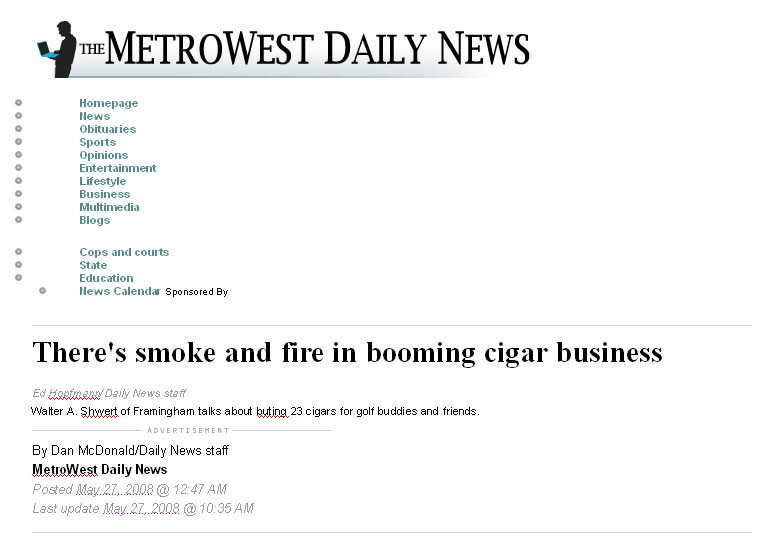Exhibit 99.1
FRAMINGHAM —
For years, Norman Sharp saw cigars going the way of martinis and red meat a social faux pas blacklisted by the better angels of American culture.
However, the numbers do not lie: The cigar industry is smokin', according to the Cigar Association of America.
Sharp, president of that organization, indicated 2007 sales of large cigars defined as weighing more than 3 pounds per 1,000 cigars were the highest since the mid-1970s.
The industry hit bottom in 1993, when 2.1 billion large cigars were sold, the lowest annual total in the 20th century.
While the cigar industry as a whole surged in the mid-to-late '90s, that development "brought some negative aspects to the market, such as fly-by-night opportunists pushing bad cigars that were not properly aged," said Kevin Godbee, owner and publisher of Cigar-Review.com
More than 5.5 billion large cigars were sold last year.
The last time the industry reached that apex, the year was 1975 - before waves of anti-smoking legislation narrowed the number of places where it was socially acceptable and, more importantly, legal to smoke cigars.
Why, then, the boom?
The explanation is a case study in human nature, according to Ernest Quintiliani, manager of Watch City Cigars on Rte. 9 in Framingham.
"Keep making it the forbidden fruit and people will buy it," said Quintiliani. "You put an ax on anything and people want it. For every rabid anti-smoker, there's five people who want to start smoking."
Walter Shwert, 54, of Framingham is a Watch City regular who smokes different cigars to accompany his golf game, morning conversation, or dinner and wine.
"Maybe the older people like myself are just getting to enjoy the finer things in life," said Shwert as he pondered both the industry trends and his next cigar purchase inside Watch City.
For his part, Sharp cited a cyclical economic trend.
"Things come back around," he said.
The pinnacle of cigar consumption was reached in 1964, the year the Surgeon General of the United States first published a report highlighting the health hazards of cigarettes.
In a knee-jerk scramble to find a fix akin to cigarettes, Americans bought almost 9 billion large cigars that year.
Sales gradually tapered off, however, and the comparison of the two tobacco products agitates Godbee to this day.
"It's like comparing Thunderbird to Dom Perignon," he said. "It's a minor frustration we're oftentimes lumped in with all smokers. They're feeding an addiction. This is like a fine wine."
The perpetual cigarette taboo, however, may have helped the industry.
"Cigar smoking is simply more acceptable," said Gino Allia, owner of Victory Cigar Bar in Sudbury. "This time of year we have a big spike with younger people. Everyone graduates and they light up."
Avoiding the ire of million-dollar, anti-smoking campaigns and maintaining the aura of accomplishment or victory does not mean cigar smoking is the height of healthy living.
The American Cancer Society's Web site indicates cigar smoking can lead to cancer of the mouth, esophagus, larynx, and lungs. It also increases the risk of coronary heart disease and chronic obstructive pulmonary disease, according to that Web site.
Despite the health ramifications, the industry continues to generate billions through international trade.
Continuing with his wine analogy, Godbee said, like grapes, tobacco differs with the soil and climate.
Tobacco for some cigars hails from tropic locales like war-torn Cameroon, Costa Rica, and the Dominican Republic.
While the vast majority 95 percent by Sharp's estimate of cigars sold in the U.S. are machine made in this country, cigar imports still generate about $1.9 billion in commerce each year, said Godbee.
One cigar, the Tatuaje Cojonu, which features Nicaraguan tobacco that was rolled in Miami, may typify the international flavor of the industry.
"It's strong, but smooth with a lot of flavor," said Quintiliani. "Ten to 15 years ago I would not go near a Nicaraguan cigar. Absolutely foul. Now it's the hottest wrapper on the market."
That cigar is one of the 800 brands featured in Quintiliani's selection. Prices range from $1.75 to $34.95.
On the cheaper end of the spectrum the consumer is basically buying "floor sweepings," said Barry Cohen, who works at Watch City.
Such cigars often taste "like burning leaves, smell bad, and have the ash crumbling and falling off," said Godbee.
On the high end, long-fill tobacco elevates cigar making to an art form, said Cohen.
Out of the three parts of a cigar, filler, binder, and wrapper, most of the flavor comes from the wrapper, said Cohen.
However, blending different mixes of tobacco filler can soften, sweeten, embolden, or embitter a cigar's flavor, said Cohen.
"It's definitely a science," he said.
Some cigars are aged for years in a humidor made of Spanish cedar or mahogany at 65 percent to 70 percent humidity, said Cohen.
If the conditions are too arid, the cigar will dry out, whereas if the conditions are too moist, it will unravel.
"A stronger tobacco will age better; it'll mellow itself out," said Cohen. "It's all a matter of taste."
(Dan McDonald can be reached at 508-62... or at dmcdonal@cnc.com)
